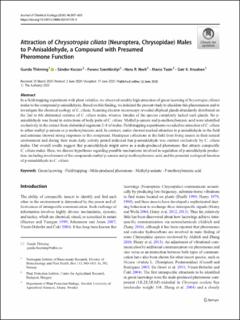| dc.contributor.author | Thöming, Gunda | |
| dc.contributor.author | Koczor, Sándor | |
| dc.contributor.author | Szentkirályi, Ferenc | |
| dc.contributor.author | Norli, Hans Ragnar | |
| dc.contributor.author | Tasin, Marco | |
| dc.contributor.author | Knudsen, Geir | |
| dc.date.accessioned | 2020-12-03T12:00:43Z | |
| dc.date.available | 2020-12-03T12:00:43Z | |
| dc.date.created | 2020-08-14T18:06:36Z | |
| dc.date.issued | 2020-06-26 | |
| dc.identifier.citation | Journal of Chemical Ecology. 2020, 46 (7), 597-609. | en_US |
| dc.identifier.issn | 0098-0331 | |
| dc.identifier.uri | https://hdl.handle.net/11250/2711696 | |
| dc.description.abstract | In a field-trapping experiment with plant volatiles, we observed notably high attraction of green lacewing (Chrysotropia ciliata) males to the compound p-anisaldehyde. Based on this finding, we initiated the present study to elucidate this phenomenon and to investigate the chemical ecology of C. ciliata. Scanning electron microscopy revealed elliptical glands abundantly distributed on the 2nd to 6th abdominal sternites of C. ciliata males, whereas females of the species completely lacked such glands. No p-anisaldehyde was found in extractions of body parts of C. ciliata. Methyl p-anisate and p-methoxybenzoic acid were identified exclusively in the extract from abdominal segments 2–8 of males. Field-trapping experiments revealed no attraction of C. ciliata to either methyl p-anisate or p-methoxybenzoic acid. In contrast, males showed marked attraction to p-anisaldehyde in the field and antennae showed strong responses to this compound. Headspace collections in the field from living insects in their natural environment and during their main daily activity period indicated that p-anisaldehyde was emitted exclusively by C. ciliata males. Our overall results suggest that p-anisaldehyde might serve as a male-produced pheromone that attracts conspecific C. ciliata males. Here, we discuss hypotheses regarding possible mechanisms involved in regulation of p-anisaldehyde production, including involvement of the compounds methyl p-anisate and p-methoxybenzoic acid, and the potential ecological function of p-anisaldehyde in C. ciliata. | en_US |
| dc.language.iso | eng | en_US |
| dc.publisher | Springer Nature | en_US |
| dc.rights | Navngivelse 4.0 Internasjonal | * |
| dc.rights.uri | http://creativecommons.org/licenses/by/4.0/deed.no | * |
| dc.title | Attraction of Chrysotropia ciliata (Neuroptera, Chrysopidae) Males to P-Anisaldehyde, a Compound with Presumed Pheromone Function | en_US |
| dc.type | Peer reviewed | en_US |
| dc.type | Journal article | en_US |
| dc.description.version | publishedVersion | en_US |
| dc.rights.holder | © The Author(s) 2020 | en_US |
| dc.source.pagenumber | 597-609 | en_US |
| dc.source.volume | 46 | en_US |
| dc.source.journal | Journal of Chemical Ecology | en_US |
| dc.source.issue | 7 | en_US |
| dc.identifier.doi | 10.1007/s10886-020-01191-5 | |
| dc.identifier.cristin | 1823425 | |
| dc.relation.project | Norges forskningsråd: 244526 | en_US |
| cristin.ispublished | true | |
| cristin.fulltext | original | |
| cristin.qualitycode | 1 | |

